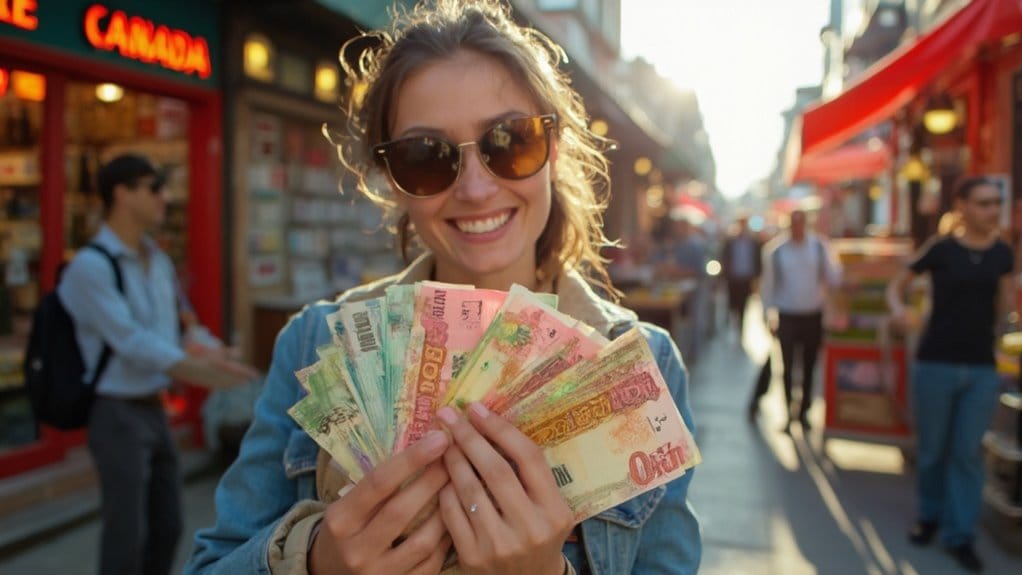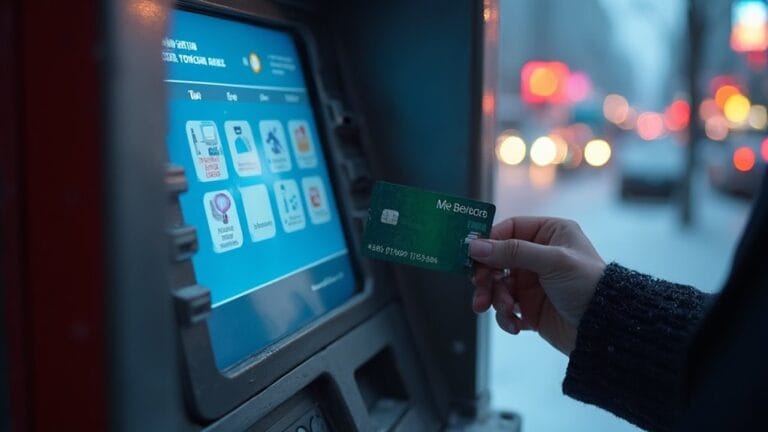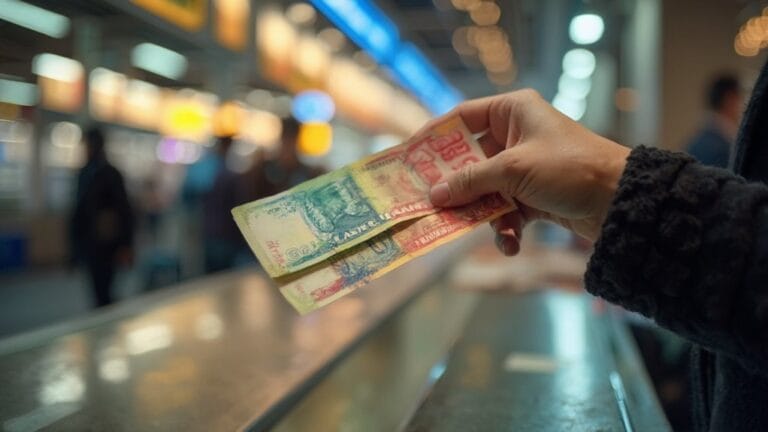When you're planning a trip to Canada from the US, picking the right currency exchange options can really make a difference. Seriously, skip those airport kiosks—they'll hit you with awful rates. Instead, try local Canadian banks like TD or Scotiabank for a good deal. You might also want to hit up ATMs, since they often offer better rates than traditional banks. Don't forget about credit cards with no foreign transaction fees—you'll thank yourself later! Keep an eye on exchange rates with handy apps, and you might just end up with more to spend on those tasty maple syrup goodies. You won't want to miss what else can help you save!
Key Takeaways
- Use Canadian banks like Scotiabank and TD Bank for reliable local currency exchange with competitive rates.
- Avoid airport kiosks for currency exchange; instead, withdraw cash from ATMs for better rates and lower fees.
- Consider setting up a USD bank account to manage currency fluctuations and minimize conversion costs during travel.
- Pay in local currency to avoid merchant conversion fees and ensure clearer transaction costs.
- Utilize currency exchange alerts and multi-currency cards to optimize rates and manage travel expenses effectively.
Best Banks for Currency Exchange
When it comes to currency exchange for your travels between the US and Canada, convenience is key. You're probably wondering where to get the best exchange rates and which banks to turn to. If you're in Canada, banks like Scotiabank, the Canadian Imperial Bank of Commerce, and TD Bank (that's Toronto Dominion, not the other TD!) are solid choices. They all offer currency exchange at local branches, making it easy to swap your cash.
On the US side, Bank of America lets you exchange currency online or in-branch, but watch out for those delivery fees! Citi is another option, boasting exchange services for over 50 currencies, though non-premium account holders might face extra fees. Currency exchange at banks is generally considered safe and trustworthy for currency transactions.
When you're comparing banks, think about their exchange methods. Some banks, like TD Bank in the US, charge a flat fee for online orders, while others may have different limits. So, use bank comparison strategies to guarantee you're getting the best deal. And hey, don't forget about ATMs in Canada—they often provide better rates than banks! With the right approach, you'll have all the cash you need for your adventure.
Tips to Minimize Exchange Fees
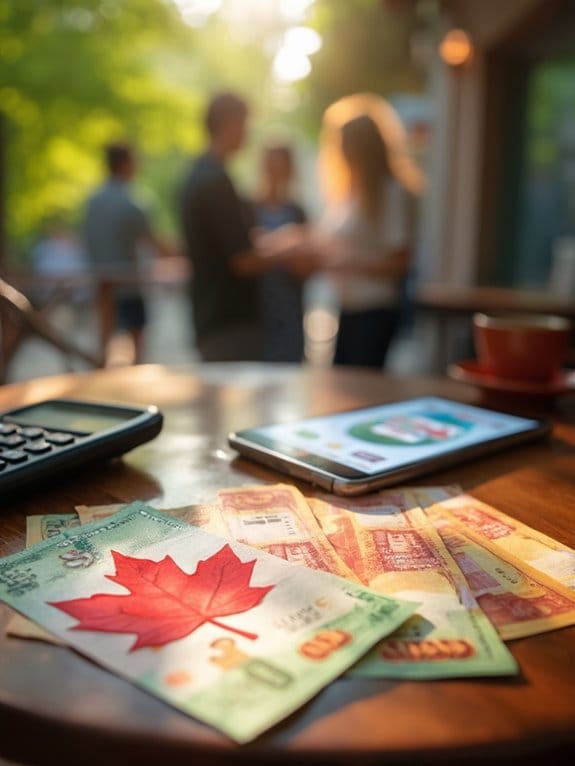
Before you set off on your US-Canada adventure, it's smart to contemplate ways to minimize exchange fees. First off, think about getting cash in advance at your bank. It can save you a bundle compared to those pricey airport kiosks. Also, if you're planning to travel often, consider setting up a USD bank account. This gives you flexibility and helps you dodge those pesky daily currency fluctuations.
Now, let's talk credit cards. Opt for one that has no foreign transaction fees; it's a game-changer! When making purchases, using a USD credit card can keep those fees at bay. And don't forget about ATM withdrawals—use them wisely. Withdraw larger amounts at once to snag better rates, and try to avoid ATMs in touristy spots. Using ATMs with home country bank cards can also help you access cash with lower fees.
Timing is everything too! Use currency apps to monitor exchange rates and find the best times to convert your money. And remember, it's easy to overestimate how much cash you'll need. Plan wisely and only exchange what you'll use. You'll keep more of your hard-earned cash for that amazing poutine or maple syrup you've been dreaming of!
Understanding Foreign Transaction Fees
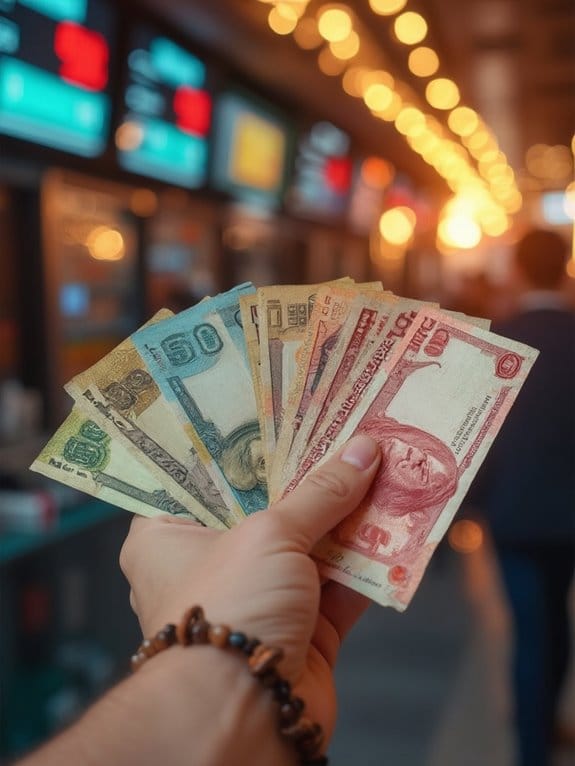
Often overlooked, foreign transaction fees can greatly impact your travel budget. If you're planning a trip to Canada, it's essential to be aware of these sneaky charges that usually hover around 3% of your purchases. Imagine this: you spend $5,000, and suddenly, you're hit with an extra $150 just for using your credit card! Yikes!
These fees don't just apply when you're shopping in person; they can sneak in during online purchases from foreign retailers too. That's why transaction fee awareness is vital. Luckily, there are credit card strategies to dodge these pesky fees. For instance, cards like the Chase Sapphire Preferred don't charge foreign transaction fees at all. And if you happen to have a Capital One or Discover card, you're in the clear too! Many travel-focused cards waive these fees, making them a smart choice for international travelers.
If you're feeling adventurous, consider using debit cards like the Charles Schwab Bank Investor Checking, which reimburses those foreign fees. Or, try alternative payment methods like Apple Pay for a seamless experience. So, next time you're in Canada, keep these tips in mind and save those extra bucks for poutine and maple syrup!
Cross-Border Banking Solutions
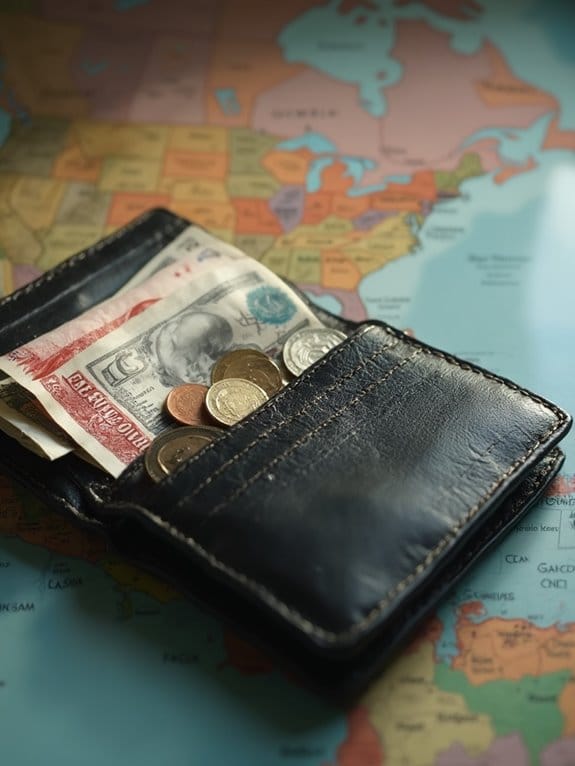
Maneuvering foreign transaction fees is just one aspect of managing your finances while traveling between the U.S. and Canada. Ever think about how nice it'd be to have banking flexibility at your fingertips? Cross-border banking solutions are a game changer! Imagine being able to transfer money instantly without those pesky fees. Services like Visa Direct let you move up to $2,500 a day, while TD Global Bank Transfer allows for $6,500. That's a lot of poutine or maple syrup right there!
With options like the RBC Cross-Border Bundle, you can enjoy unlimited transfers and a single sign-in for both U.S. and Canadian accounts. No more juggling multiple apps—just straightforward access to your funds. Plus, BMO's online tools make paying U.S. bills and depositing checks a breeze. Additionally, you can link U.S. and Canada bank accounts for easy balance viewing through TD's EasyWeb platform.
And let's not forget about the extensive ATM networks! TD Bank has over 1,200 locations and fee-free access with BMO ATMs. So, whether you're snowboarding in Whistler or chilling in Miami, you'll have peace of mind knowing your money is just a tap away. Embrace those cross-border benefits, and travel with confidence!
Travel Insurance and Cash Access
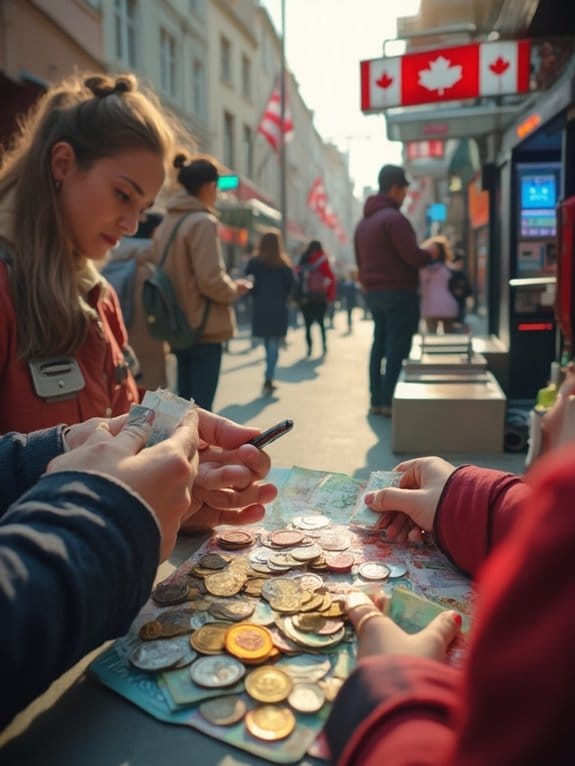
Travel insurance and cash access are essential components of a seamless trip between the U.S. and Canada. You wouldn't want to face a hefty medical bill while enjoying poutine in Quebec, right? That's where travel insurance comes in handy. It's vital for covering those unexpected expenses, especially since Canadian health plans won't foot the entire bill outside Canada. With options like RBC Insurance, you get 24/7 emergency assistance and even multilingual support—which can be a lifesaver!
Now, let's talk cash management. When you arrive, you'll want some cash for those quirky roadside attractions or that artisanal maple syrup shop. But here's a tip: stick to bank-affiliated ATMs to avoid those pesky fees. Banks typically offer better exchange rates than other outlets, so consider purchasing foreign currency before traveling. And while credit cards are great for reservations and often offer better exchange rates, withdrawing cash from them can hit your wallet hard with fees. If you can, consider opening a U.S.-based bank account for easy access to no-fee ATMs.
Lastly, always keep a backup source of funds, just in case you encounter any unexpected hiccups. Being prepared means you can focus on having a blast and making unforgettable memories!
Comparing Exchange Rates Effectively
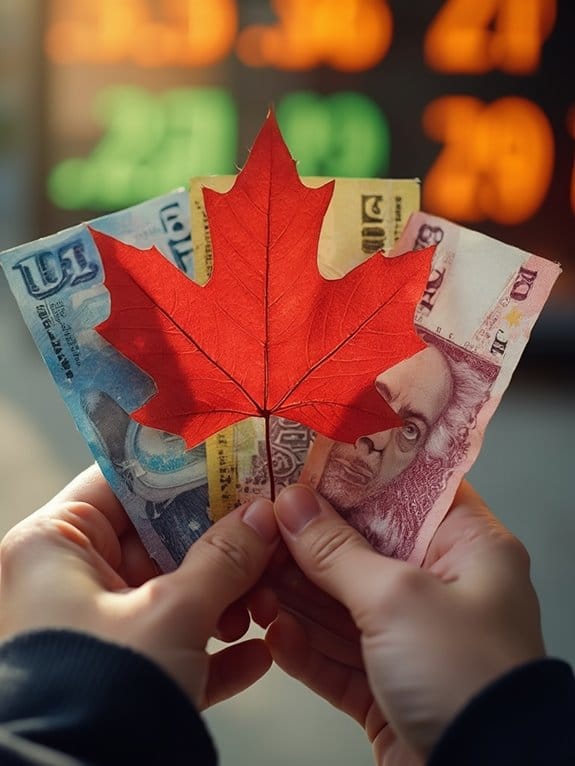
When it comes to comparing exchange rates effectively, you'll want to focus on finding the best value for your money. Start by aiming for the mid-market rate, which is what banks use when trading with each other. Don't be fooled by hidden markups; many providers sneak in extra fees that can cost you more than the actual conversion fee. For instance, as of December 2024, the best exchange rate is currently 1 USD = 1.4164 CAD.
To avoid surprises, check if your credit card has foreign transaction fees—these can add around 2.5% to your costs! For the best results, steer clear of currency exchangers found at airports and hotels; they often charge outrageous fees. Instead, consider using online services like Wise, which offer transparent rates and handy features like rate alerts. These alerts can help you snag the best time to exchange your money.
You might also want to think about multi-currency cards to save on exchange rates during your travels. Finally, always pay in the local currency to dodge those pesky additional fees. By comparing rates from various providers and keeping an eye on those hidden markups, you'll maximize your spending power and make the most of your trip!
Frequently Asked Questions
How Do I Find the Best Exchange Rate Today?
You're wondering how to find the best exchange rate today? Start by checking online tools that compare local rates. Keep an eye on live updates; rates fluctuate, and the right moment could save you money!
Can I Exchange Currency at Any Bank Branch?
Yes, you can exchange currency at most bank branches. Just be aware of currency exchange fees and different bank exchange policies, as they can affect the amount you ultimately receive in your desired currency.
What Identification Is Needed for Currency Exchange?
For currency exchange, you'll need proper identification types, like a passport or driver's license. Some services might require additional documents, especially for larger transactions, so it's wise to check ahead for specific passport requirements.
Are There Limits on How Much Currency I Can Exchange?
Did you know travelers can exchange up to $1,000 per day at certain locations? While there aren't strict currency exchange limits in Canada, keep international travel regulations in mind for larger amounts needing declaration.
Is It Better to Exchange Money Before or After Traveling?
It's usually better to exchange money before traveling. You can often avoid higher exchange fees and keep your travel budget intact, ensuring you have cash on hand as soon as you arrive at your destination.

